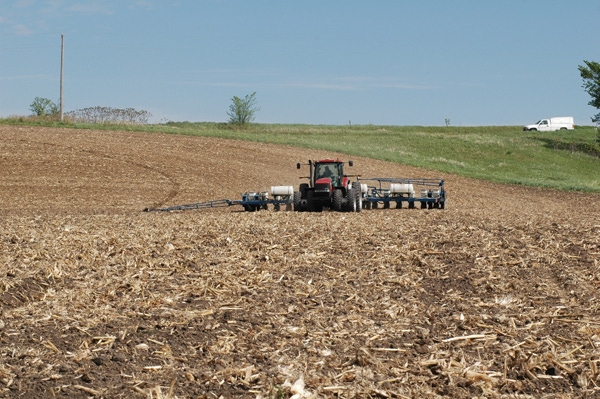March 25, 2013

Corn and soybean production prospects in the U.S. in 2013 will hinge mostly on the nature of the growing season and yield prospects. The magnitude of planted acreage, however, will provide the basis for anticipating total production. Likely acreage has been the topic of discussion all winter, with projections in a fairly wide range.
Anticipating planted acreage of the two crops is complicated by a number of factors. The first issue is the magnitude of acreage available for planting of all spring crops. Some additional cropland acreage has become available in 2013 due to fewer acres being enrolled in the Conservation Reserve Program. That acreage is reported at 27.04 million acres, 2.62 million fewer than enrolled last year. How much of that reduction will be planted to crops in 2013 is not known.
Winter wheat seedings reported by the USDA in January were nearly 600,000 acres larger than seedings of a year ago. The acreage of soft red winter wheat is up about 1.3 million acres while seedings of other classes of wheat were less than those of a year earlier. Some of the increase in sort red winter wheat acreage may be double-cropped with soybeans. The condition of the hard red winter wheat crop going into dormancy this winter was generally quite poor. While ratings have improved somewhat, the poor condition suggests that more than the normal amount of that acreage may be abandoned. Depending on moisture conditions going forward, some abandoned acres may get replanted to other crops this spring.
Additionally, the acreage of spring planted crops will be influenced by spring weather conditions and the magnitude of prevented plantings. Prevented planted acres totaled only 1.24 million acres in 2012, after being quite large in 2009, 2010 and 2011. In those three years, prevented plantings were reported at 4.18 million, 6.89 million and 9.62 million acres, respectively. Prospects for prevented planting this year once again focus on the northern Plains states where snow cover suggests the potential for spring flooding. An increase in prevented plantings would presumably reduce the total acreage planted this spring. The potential magnitude of that acreage will not be known for several weeks.
The second issue surrounding acreage is the share of the total available acreage that will be planted to individual crops. In general, it is believed that corn and soybeans will be very competitive with cotton and rice acreage in the Delta and portions of the Southeast. As a result, corn and soybeans are expected to garner a larger share of the acreage pie in those areas. In the northern Plains states, the relevant competition will be between spring wheat, corn, soybeans and other oilseed crops. The outcome of that competition may be mostly of a function of spring weather.
Like what you're reading? Subscribe to CSD Extra and get the latest news right to your inbox!
Taken together, these issues suggest that total corn and soybean acreage could be near the level of 2012. Early expectations were for corn acreage to increase modestly and for soybean acreage to be about unchanged. Changing price relationships and a more favorable spring price for soybeans for crop revenue insurance may have altered those expectations slightly. The USDA will report the results of the spring planting survey in the Prospective Plantings report to be released March 28. Intentions for corn and soybean plantings equal to or slightly larger than those of last year would not be a surprise. Given that planting of those crops in the Corn Belt will be later than last year's planting, there is more opportunity for actual plantings to deviate from intentions this year. Weather conditions, planting progress and price relationships will be monitored closely to judge potential changes.
The later planting this season is also generating some further discussion of yield potential, particularly for corn. As learned again last year, corn yields or mostly determined by summer weather conditions. However, agronomic research clearly indicates that planting date, everything else equal, can have some influence on yield outcome. In particular, there is an increasingly large yield penalty associated with corn planted "late." That same research suggests that maximum yield potential is associated with corn planted in a fairly large window of time. For much of the Midwest, that optimum planting window is from about mid-April through early May, with increasingly large yield penalties after mid-May.
At this juncture the potential for U.S. average corn and soybean yields near trend value in 2013 are still in place. Still, the likelihood of some planting delays, along with lingering drought conditions in western areas, provides the basis for considerable yield uncertainty for corn in 2013. If these conditions persist, new-crop corn futures could regain some of the losses occurred since late 2012. For those with crop revenue insurance, pricing opportunities for both corn and soybeans should probably be judged in context of the spring crop insurance prices, with prices well above those levels representing sales opportunities.
Read the article at farmdocDaily.
You might also like:
Drought, Flooding, Warm Weather for Spring
Factor Field History, Weather into Crop Disease Management Decisions
3 Pre-Planting Yield Booster Tips
You May Also Like




